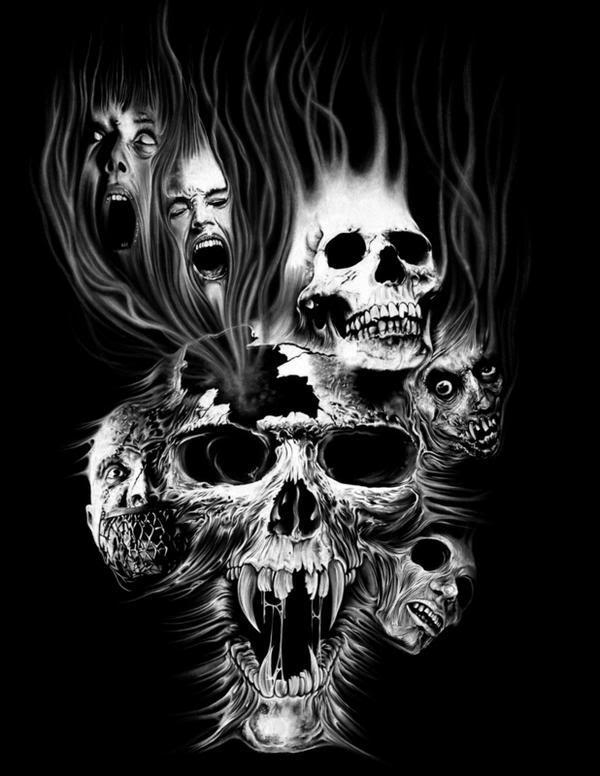Skulls that supposedly horribly scream or cause any type of poltergeist or ghostly phenomena and/or activity. In many cultures and countries skeletons have, perhaps understandably, been associated with death and haunting. However, a peculiarly English preoccupation, in terms of ghosts and hauntings, has been with the skulls alone — skulls which bitterly resent any indignity offered them.
The tradition of screaming skulls seems to be almost entirely isolated to England, where stories of these mischievous bone locked spirits abound. A screaming skull is basically a skull of dubious origin, said to cause great havoc - storms, poltergeist activity, and (given its namesake) unearthly screams - when it is removed from its pride of place within a stately home, or other ancient abode. Just how each skull came to reside within the house, is the subject of colourful stories, which also explain why the skull is so unwilling to return to the grave.
Many of the stories about the skulls origins do not stand up to the scrutiny of investigation, but the actual tradition itself bears interest, and can be seen as a folklore motif widespread throughout the English counties.
It has been suggested that the tradition of screaming skulls may be related in some way to a fragmented ancient tradition, associated with the reverence for the head. The Celts in particular were worshippers of the head. There have been many archaeological finds from the Iron Age to suggest that this is so, from skull shrines to the plethora of carved stone heads. The tradition has also been passed down in the Celtic Myths, from Bran's sacred head to the beheading motif found in Cu Chulainn and other folklore. The only problem with this theory is that the tradition of screaming skulls seems restricted to England, and is not found in Wales, Scotland and Ireland. Counties where you would more readily expect to find fragments of surviving Celtic traditions. So whether there is any connection with older traditions is difficult to quantify, and as the stories do not seem to date back further than the middle of the 16th century the tradition may be relatively new.
In some stories these skulls have almost become the 'luck' of the house, in much the same way as some stately homes and castles have an heirloom, which in tradition must be kept safe to maintain good luck for the home and the family. Here is a selection of some of the most famous and well-documented screaming skulls in Britain:
Unexplained Mysteries of Screaming Skulls
The tradition of screaming skulls seems to be almost entirely isolated to England, where stories of these mischievous bone locked spirits abound. A screaming skull is basically a skull of dubious origin, said to cause great havoc - storms, poltergeist activity, and (given its namesake) unearthly screams - when it is removed from its pride of place within a stately home, or other ancient abode. Just how each skull came to reside within the house, is the subject of colourful stories, which also explain why the skull is so unwilling to return to the grave.
Many of the stories about the skulls origins do not stand up to the scrutiny of investigation, but the actual tradition itself bears interest, and can be seen as a folklore motif widespread throughout the English counties.
It has been suggested that the tradition of screaming skulls may be related in some way to a fragmented ancient tradition, associated with the reverence for the head. The Celts in particular were worshippers of the head. There have been many archaeological finds from the Iron Age to suggest that this is so, from skull shrines to the plethora of carved stone heads. The tradition has also been passed down in the Celtic Myths, from Bran's sacred head to the beheading motif found in Cu Chulainn and other folklore. The only problem with this theory is that the tradition of screaming skulls seems restricted to England, and is not found in Wales, Scotland and Ireland. Counties where you would more readily expect to find fragments of surviving Celtic traditions. So whether there is any connection with older traditions is difficult to quantify, and as the stories do not seem to date back further than the middle of the 16th century the tradition may be relatively new.
In some stories these skulls have almost become the 'luck' of the house, in much the same way as some stately homes and castles have an heirloom, which in tradition must be kept safe to maintain good luck for the home and the family. Here is a selection of some of the most famous and well-documented screaming skulls in Britain:
Unexplained Mysteries of Screaming Skulls


No comments:
Post a Comment